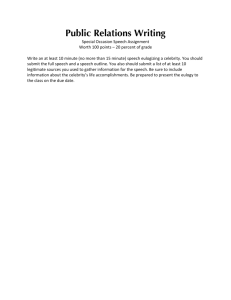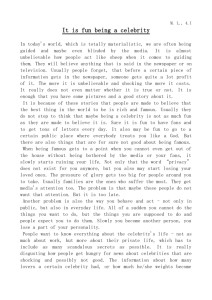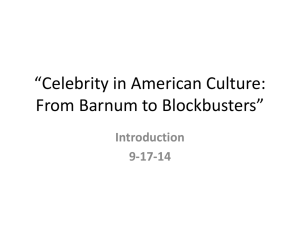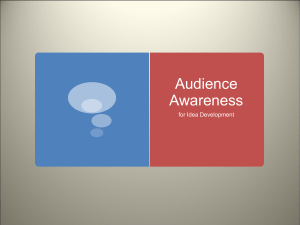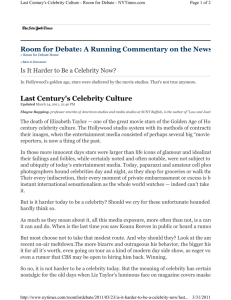Common Celebrity.
advertisement
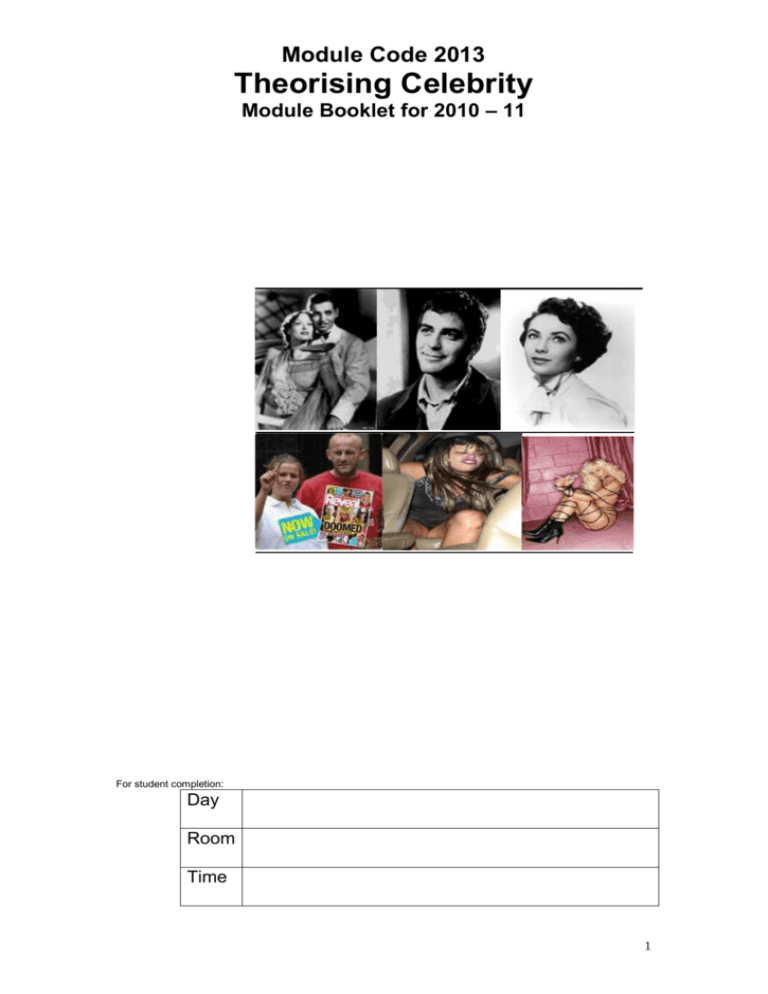
Module Code 2013 Theorising Celebrity Module Booklet for 2010 – 11 _____________________________________________ For student completion: Day Room Time 1 Module detail Credits Module leader Assessment Assessment Dates 20 Milly Williamson Room, 101 Gaskell Building Email: Milly.Williamson@brunel.ac.uk Method Proportion of marks 1)1500 word analysis 40% 2) 3000 word essay 60% 1) Analysis: Friday 24, February 2012 2) Essay: Monday 2 April, 2012 Access to support material Support material is provided electronically via the University’s u-Link system. You can gain access to the u-Link system via the following web page: http://www.brunel.ac.uk/intranets/weblearn/ Introduction/aims/background The aim of this module is to: • To provide an understanding of the historical social and cultural conditions which have contributed to the emergence of celebrity. • To examine the economic context for the production of celebrity within the cultural industries. • To consider the significant academic theories and debates about the role and function of celebrity in modern mass media dominated societies. • To examine the social, cultural and economic meanings of a range of historical and contemporary celebrities. Celebrity culture is a prominent feature of modern mass mediated society. We seem to be surrounded by more celebrity figures than ever before and the treatment by the media of well-known individuals from all walks of life increasingly takes on the representational patterns and discursive repertoires associated with celebrity. Figures from the world of politics, sport, and even some well-known academics are represented in ways usually connected with films stars and entertainment celebrities. Also, with the rise of reality TV shows such as Big Brother, there is the emergence of the ‘average person’ as celebrity, who, for a short period, is famous not because of their extraordinariness, but on the contrary because of their ordinariness. 2 This module will unpack the phenomenon of celebrity and will focus on the main academic approaches to celebrity. We will examine the phenomenon of celebrity as the outcome of specific historical and contemporary social and cultural processes. We will ask: what is a celebrity? Is celebrity culture a product of the commodification of the individual? Or is it the outcome of the breakdown of old forms of social organisation and community? What is the social function of celebrity? How can we understand the paradox at the heart of celebrity discourses that pose the idea of the celebrity as a uniquely gifted individual and that insist that anyone can achieve fame? The sites for the consumption of celebrity are also on the increase, with the emergence of magazines, websites, television shows and newspapers that are entirely dedicated to celebrities. Meanwhile, the traditional machinery for the production, promotion, marketing and distribution of celebrity is also expanding. In this sense, celebrity culture can also be understood as an industry. In this module we will analyse the production processes and the economic functioning of the celebrity industry. We will also consider the way that celebrity is consumed by examining specific celebrities and their audiences. Learning outcomes There are learning outcomes that you must achieve in order to be awarded the credits for this module. These learning outcomes are listed below: By the end of the module students should be able to demonstrate a critical understanding of the relationship between modernity, the development of the mass media, and the rise of celebrity culture; By the end of the module students should be able to demonstrate an understanding of the complex relationship between the production of media celebrities and their reception by diverse audiences. By the end of the module students should be able to demonstrate the ability to summarize and evaluate a range of key theories relating to the history and development of ‘celebrity’ both as a concept and as a social practice; By the end of the module students should be able to demonstrate the ability to critically evaluate the production of celebrity images and values. 3 Method of teaching Lectures, seminars, screenings. Please note that no timetabling details can be given at this stage. 4 Teaching Programme Research Weeks for 2012 will be as follows:- Teaching Programme This module runs in term two. TERM 2 Modernity and the mass media: the emergence of celebrity. 16 09/01/2012 to 13/01/2012 Celebrity, stardom and history: the changing social meanings of fame. 17 16/01/2012 to 20/01/2012 Producing Celebrity: the economics of the industry of celebrity. 18 23/01/2012 to 27/01/2012 19 30/01/2012 to 03/02/2012 20 06/02/2012 to 10/02/2012 21 13/02/2012 to 17/02/2012 22 20/02/2012 to 24/02/2012 23 27/02/2012 to 02/03/2012 The press, publishing and celebrity culture: a case of tabloidization? Celebrity and Cultural Values. ASK/RESEARCH WEEK – NO TEACHING Gender and Celebrity First assessment DUE Youth, cult, and celebrity culture. Common Celebrity. 24 05/03/2012 to 09/03/2012 25 12/03/2012 to 16/03/2012 26 19/03/2012 to 23/03/2012 27 26/03/2012 to 30/03/2012 Star Gazing: celebrities, audiences and consumption Celebrity in the era of Convergence Media. Independent preparation for essay and tutorials Assessment 1)1500 – 2000 word analysis: 5 The event or ‘pseudo-event’ has always been important to celebrity culture. In 1910 Carl Laemmle produced the first celebrity ‘pseudo-event’ when he published a denial of the rumour that his leading lady, Florence Lawrence, had been killed in a tram car accident in St Louis. Of course, Laemmle himself started the rumour. He then invited the press to come to a press conference in St Louis with Miss Lawrence to prove that she was a live and well. For this assessment you must produce a written analysis of a recent celebrity event or ‘pseudo-event’. You must examine how the event was constructed by publicity agents and/or the media and you must explain the event with reference to at least one relevant academic theory. You may choose your own event, but you must confirm it with me first. 2) 2500 – 3000 word essay: Please choose one question from the list below: 1. Choose two films. Compare the way these films construct the dilemmas of fame. Refer to at least two academic sources in your answer. 2. Do celebrities contribute to the ‘myth of success’? Refer to at least two academic sources in your answer. 3. Why is the existence of a modern mass media considered to be fundamental to the rise and expansion of celebrity culture? Refer to at least two academic sources in your answer. 4. Assess the view that celebrities construct ‘para-social’ interaction for young consumers. Present arguments for and against this view. Draw on at least two academic sources in your answer and use examples. 5. Is celebrity culture part of a social hierarchy? Refer to at least two academic sources in your answer and provide examples. 6. Is celebrity a form of cultural capital? Draw on at least two academic sources in your answer and provide examples. 7. In what ways can a celebrity be seen as a commodity? Refer to academic sources in your answer and provide examples. 8. Critically examine the process by which a celebrity is constructed. Refer to at least two academic sources in your answer and provide a celebrity example. How the assessment relates to the learning outcomes Assessment One, 1500 – 2000 word analysis: this assessment particularly asks you to focus on the learning outcomes where you can ‘demonstrate an understanding of the complex relationship between the production of media celebrities and their reception by diverse audiences’ and your ‘ability to critically evaluate the production of celebrity images and values’. 6 Assessment Two, 2500 – 3000 word essay: all essay questions will be expected to provide a discussion of the appropriate context and summarise the relevant theories. This relates to the two remaining learning outcomes: ‘demonstrate a critical understanding of the relationship between modernity, the development of the mass media, and the rise of celebrity culture’ and ‘demonstrate the ability to summarize and evaluate a range of key theories relating to the history and development of ‘celebrity’ both as a concept and as a social practice’. Key Texts Excerpts of many of the set readings can be found in: Marshall, P. D. (ed.) (2006) The Celebrity Culture Reader, London: Routledge Redmond, S. and S. Holmes (eds.) (2007) Stardom and Celebrity: A Reader, London: Sage. For useful overviews and summaries: Turner, G. (2004) Understanding Celebrity, London: Sage. Evans, J. and D. Hesmondhalgh (eds.) (2005) Understanding Media: Inside Celebrity, Open University Press. ______________________________________________________________ Weekly Schedule Week 16 Session One: Modernity and the mass media: the emergence of celebrity. This lecture will examine the historical roots of celebrity culture. We will explore the differing accounts of its emergence and consider the twin contexts of the rise of bourgeois democracy and the mass media. Screening: Life of Brian (1979 Terry Jones) Set Reading: Richard de Cordova (1990) ‘Chapter Two: The Emergence of the Star System’ in Picture Personalities: The emergence of the star system in America, Urbana and Chicago: University of Illinois Press. This has been reproduced in: Sean Redmond and Su Holmes (eds.) (2007) Stardom and Celebrity: A Reader, Chapter 11, pgs. 132 – 141 and in (1991) Gledhill, C. (ed.) Stardom: the Industry of Desire, London: Routledge, and Marshall, P. D. (ed.) (2006) The Celebrity Culture Reader, London: Routledge. Further Reading: Robert C. Allen (1980) Vaudeville in Film, 1895 – 1915, New York: Arnos Press. 7 Charles Ponce de Leon (2002) Self Exposure: human interest journalism and the emergence of celebrity in America 1890 – 1940, Chapel Hill and New York: The University of North Carolina Press. Alexander Walker (1970) Stardom: The Hollywood Phenomenon, New York: Stein and Day. Adorno, T. (Crook, S. ed.) (1994) Adorno: Stars Down to Earth and Other Essays on the Irrational in Culture, London: Routledge. Babington, B. (2001) British Stars and Stardom: From Alma Taylor to Sean Connery, Manchester: Manchester University Press. Braudy, L (1986) The Frenzy of Renown: Fame and its History, New York/Oxford: Oxford University Press. Dyer, R. (2004) Heavenly Bodies: Film Stars and Society, London: Routledge, Second Edition, (first edition published in 1986), ‘Introduction’. Gledhill, C. (ed.) (1991) Stardom: the Industry of Desire, London: Routledge Giles, D. (2000) Illusions of Immortality: a psychology of fame and celebrity, London: MacMillan, Chapter Two, pp. 12 – 32. Foulkes, N. (2003) Scandalous Society: Passion and Celebrity in the Nineteenth Century, London: Abacus. Marshall, P. D. (1997) ‘Tracing the Meaning of the Public Individual’ in Celebrity and Power: Fame in Contemporary Culture, Minneapolis/ London: University of Minnesota Press, pp. 3 – 26. Schickel, R (1985) Common Fame: the Culture of Celebrity, London: Pavilion, Chapter Two pp. 23 – 64 and Chapter Seven, 255 - 285. Turner, G (2004) Understanding Celebrity, London: Sage (chapter one). 8 Week 17 Session Two: Celebrity, stardom and history: the changing social meanings of fame. There is considerable debate over the cultural politics of celebrity. For some celebrity has represented a democratisation of the public sphere and an expansion of democratic participation. For others, celebrity is a sign of the persistence of hierarchy and social exclusion. This lecture will examine this debate across the 20th and into the 21st century. Screening: The Truman Show Set Reading: Rojek, C (2001) Celebrity, London: Reaktion, Chapter One, pp. 9 – 49. Alberoni, F (orig. 1963) ‘The Powerless Elite: Theory and Sociological Research on the Phenomenon of Stars’, in Sean Redmond and Su Holmes (eds.) (2004) Stardom and Celebrity: A Reader, London: Sage. Nick Couldry (2001) ‘The Hidden Injuries of Media Power’, Journal of Consumer Culture, Vol 1 (2), 155 – 177. This article is available on the module u-link pages. Further Reading: Adorno, T. And M. Horkheimer (orig. 1963/69) ‘The Culture Industry’ in Sean Redmond and Su Holmes (eds.) (2007) Stardom and Celebrity: A Reader, London: Sage. Austin, T. and Barker, M. (Eds.) (2001) Contemporary Hollywood Stardom, London: Arnold. Boorstin, D. (1971) The Image: a guide to pseudo-events in America, New York: Atheneum. Braudy, L (1986) The Frenzy of Renown: Fame and its History, New York/Oxford: Oxford University Press. Corner, J. And D. Pels (2003) Media and the Restyling of Politics, London: Sage. Couldry, N. (2003) Media Rituals: A Critical Approach, London: Routledge. Dyer R. (1998 [1979]) Stars, London: BFI, ‘Introduction’. Dyer, R. (2004) Heavenly Bodies: Film Stars and Society, London: Routledge, Second Edition, (first edition published in 1986), ‘Introduction’. Evans, J. (2005) ‘Celebrity, Media and History’ in Evans, J. And D. Hesmondhalgh, (eds.) Understanding Media: Inside Celebrity, Open University Press, pp. 11 – 56. Gledhill, C. (ed.) (1991) Stardom: the Industry of Desire, London: Routledge 9 Giles, D. (2000) Illusions of Immortality: a psychology of fame and celebrity, London: MacMillan, Chapter Two, pp. 12 – 32. Turner, G (2004) Understanding Celebrity, London: Sage (chapter five). Turner, G., Bonner, F., & Marshall, P.D. (2000) Fame Games: The Production of Celebrity in Australia, Melbourne: Cambridge University Press. Wilson, E. (2000) Bohemians: The Glamorous Outcasts, London: I.B. Tauris. Week 18 Session Three: Producing Celebrity: the economics of the industry of celebrity. This lecture considers the view that the celebrity is a commodity within the cultural industries. We will examine the role of celebrity in the economic activities of these industries and we will also consider how the celebrity is ‘produced’. Finally, we will examine the impact of globalisation on the production of celebrity. Screening: A Star is Born Set Reading: Hesmondhalgh, D. (2005) ‘Producing Celebrity’ in Evans, J. and D. Hesmondhalgh (eds.) Understanding Media: Inside Celebrity, Open University Press, pp. 97 – 134. Gamson, J (1994) ‘The Organization of Industrialized Production’ in Claims to Fame: Celebrity in Contemporary America, Berkeley/ LA/ London: University of California Press, pp. 59 – 78. Further Reading Turner, G. (2004) ‘Chapter Two: The economy of celebrity’ in Understanding Celebrity, London: Sage, pp. 31 – 51. Cashmore, E. (2006) ‘Chapter Four: Fabricating Fame’ in Celebrity Culture, London: Routledge. Gabler, N. (1998) Life in the Movie: How Entertainment Conquered Reality, New York: Knopf. Holt, J. (2004) ‘In deregulation we trust: the synergy of politics and industry in Regan-era Hollywood’, in Schatz, T. (ed.) (2004) Hollywood, Critical Concepts in Media and Cultural Studies, London: Routledge, Vol. III, Part Nine, pp. 330 – 342. Klein, N. (2001) No Logo, London: Flamingo. Lacey, J. (2003) ‘”A Galaxy of Stars to Guarantee Ratings”: Made-fortelevision Movies and the Female Star System’, in Austin, T., and Barker, M. (eds.) Contemporary Hollywood Stardom, London: Arnold, pp. 187 – 198. Marshall, P. D. (1997) ‘The System of Celebrity’ in Celebrity and Power: Fame in Contemporary Culture, Minneapolis/ London: University of Minnesota Press, pp. 185 – 202. 10 McDonald, P (2000) The Star System: Hollywood’s production of popular identity, London: Wallflower. McCracken, G. (2005) ‘Who is the Celebrity Endorser? Cultural Foundations of the Endorsement Process’, in Culture and Consumption II: Markets, Meaning, and Brand Management, Bloomington/ Indianapolis: Indiana University Press, pp. 97 – 188. Schatz, T. (ed.) (2004) Hollywood, Critical Concepts in Media and Cultural Studies, London: Routledge, Vol. II, part 6 (‘The Star System and Star Studies’, pp. 147 – 249.) Schickel, R (1985) Common Fame: the Culture of Celebrity, London: Pavilion, Chapter Five, pp. 134 – 208. Turner, G., Bonner, F., & Marshall, P.D. (2000) Fame Games: The Production of Celebrity in Australia, Melbourne: Cambridge University Press. Wernick, A. (1991) Promotional Culture: Advertising, Ideology and Symbolic Expression, London: Sage. Week 19 Session Four: The press, publishing and celebrity culture: a case of tabloidization? This lecture will explore the idea that celebrity culture is invading all aspects of public life. We will examine the view that tabloids handle public figures as celebrities and will consider the view that ‘serious’ news and television is being replaced by an entertainment approach to politics. Finally, we will consider the impact of the tabloid concentration on celebrities on citizenship and the public sphere. No Screening: mini project – the press and pseudo events Set Reading Franklin, B. (1997) ‘Newszak: Regulation Excesses – Keeping it Bright, Light and Trite, Regulating the Tabloid Press in Newzak and the News Media, London: Edward Arnold. This has been republished in Biressi, A. And H. Nunn (2008) The Tabloid Culture Reader, Open University Press, pp. 13 – 22. Corner, J. (2003) ‘Mediated Persona and Political Culture’ in Corner, J. And D. Pels (2003) Media and the Restyling of Politics, London: Sage. Further Reading: Conboy, M. (2002) The Press and Popular Culture, London: Sage. Couldry, N. (2003) Media Rituals: A Critical Approach, London/ New York: Routledge. Dovey, J. (2000) Freakshow: First Person Media and Factual Television, London: Pluto. 11 Gamson, J. (1994) Claims to Fame: Celebrity in Contemporary America, Berkeley: University of California Press. Hartley, J. (1996) Popular Reality: Journalism, Modernity, Popular Culture, London: Edward Arnold. Langer, J. (1998) Tabloid Television: Popular Television and the ‘Other’ News, London: Routledge. Lumby, C. (1999) Gotcha: Life in a Tabloid World, Sydney/ London: Allen Unwin. Muir, K (2005) ‘Media Darlings and Falling Stars: celebrity and the reporting of political leaders’, Westminster Papers in Communication, Vol. 2 (2), pp. 54 – 71. Available on-line. Pels, D. (2003) ‘Aesthetic Representation and Political Style: Re-balancing identity in media democracy’ in Corner, J. And D. Pels (2003) Media and the Restyling of Politics, London: Sage. Ponce de Leon, C. (2002) ‘The Rise of Celebrity Journalism’ in SelfExposure: Human Interest Journalism and the Emergence of Celebrity in America 1890 – 1940, Chapel Hill: The University of North Carolina Press, pp. 42 – 75. Scammel, M. (2003) ‘Citizen Consumers: Toward a new marketing of politics?’, in Corner, J. And D. Pels (2003) Media and the Restyling of Politics, London: Sage. Street, J. (2003) ‘The Celebrity Politician: political style and popular culture’, in Corner, J. And D. Pels (2003) Media and the Restyling of Politics, London: Sage. Turner, G. (1999) ‘Tabloidisation, journalism and the possibility of critique’, International Journal of Cultural Studies, 2: 1, pp. 59 – 67. Week 20 Session Five: Celebrity and Cultural Values. In this lecture we will examine the different ways that the social and cultural meanings of celebrities have been understood. We will be looking at Richard Dyer’s original approach to the social meanings of fame and considering more recent ideas about the cultural values and functions of celebrity. Screening: Hannah Montana Set Reading: Weber, M. (2004 [1922]) ‘The Nature of Charismatic Domination’ in Sean Redmond and Su Holmes (eds.) Stardom and Celebrity: A Reader, London: Sage pp. 17 - 34. Originally published in German in 1922. Translated by Talcott Parsons in (1947) Theory of Social and Economic Organisation. Dyer (1998 [1979]) Stars, Second Edition, pages 46 – 53. Here Dyer applies Weber to the phenomena of stardom. 12 Rojek, (2001) Celebrity, London: Reaktion, chapter two. Further Reading: Beltán, M. (2004) ‘The Hollywood Latina Body as a Site of Social Struggle: Media constructions of stardom and Jennifer Lopez’s “cross-over butt”’, in Sean Redmond and Su Holmes (eds.) Stardom and Celebrity: A Reader, London: Sage. Bonner, F. (2005) ‘The Celebrity in the Text’ in Evans, J. And D. Hesmondhalgh, (eds.) Understanding Media: Inside Celebrity, Open University Press. Conboy, M. (2006) Celebrity and National Community, in Tabloid Britain, London: Routledge, pp. 185 – 206. Couldry, N. (2000) Media Rituals: A critical approach, London: Routledge. Dyer, R. (2004 [1986]) Heavenly Bodies: Film Stars and Society, London: Routledge, Second Edition, (particularly the Introduction). Frow, J. (1998) ‘Is Elvis a God? Cult, culture, questions of method’, International Journal of Cultural Studies, 1: 2, pp. 197 – 210. Holmes, S. (2004) ‘”Off-guard, unkempt and unready?”: Deconstructing contemporary celebrity in Heat magazine’, Television and New Media, Vol. 5(2), pp. 147 - 172. Republished in Biressi, A. And H. Nunn (2008) The Tabloid Culture Reader, Open University Press, pp. 163 – 176. McDonald, P. (1998) ‘Stars and History’ in Dyer, R., Stars, London: BFI. This is a supplementary chapter to the original 1979 edition of Stars which offers a succinct and useful contextualisation of the changes in emphasis in the study of stars. Marshall, P. D. (1997) ‘Tracing the Meaning of the Public Individual’ in Celebrity and Power: Fame in Contemporary Culture, Minneapolis/ London: University of Minnesota Press, pp. 3 – 26. Turner, G. (2004) ‘Chapter Five: The cultural function of celebrity’ in Celebrity, London: Sage. Schickel, R (1985) Common Fame: the Culture of Celebrity, London: Pavilion, Chapter Two pp. 23 – 64 and Chapter Seven, 255 - 285. Shickel, R (2000) Intimate Strangers: The Culture of Celebrity in America, Chicago: Ivan R. Dee. Simons, J (2003) ‘Popular Culture and Mediated Politics: intellectuals, elites and democracy, in in Corner, J. and D. Pels (2003) Media and the Restyling of Politics, London: Sage. Wilson, E. (1997) ‘The Unbearable Lightness of Diana’, New Left Review, Vol. I (226) 13 Week 21 Reading Week ASK Week No classes Week 22 Session Six: Gender and Celebrity. For many feminist scholars, the denigration of female pleasure in celebrity culture is part of a gendered cultural hierarchy. They seek to redress the balance by examining what is of value in female engagements with popular culture. This view is exemplified in the article by van Zoonen. More recently, feminists have suggested that there is a misogynistic quality to popular representations of female celebrities which contributes to the overall denigration of women. This lecture will explore these differing perspectives on gender and celebrity. Screening: TBA Set Reading: Negra, D and S. Holmes (eds.) (2008) ‘Going Cheap? Female Celebrity in Reality, Tabloid and Scandal Genres: Special Edition’, Genders, Issue 48. This is an on-line journal that can be accessed for free at http://www.genders.org/. You must read the introduction. Please read any further articles that interest you. Van Zoonen, L (2006) ‘The Personal, the Political and the Popular: a woman’s guide to celebrity politics, Cultural Studies, Vol. 9(3), pp. 287 – 301. This journal article will be available on U-link. Further Reading: Ehrenreich, B., Hess, E. and Jacobs, G. (1992) ‘Beatlemania: Girls Just Want to Have Fun’ in L. Lewis, The Adoring Audience, Fan Culture and Popular Media, London and New York: Routledge. Gever, M. (2003) Entertaining Lesbians: Celebrity, Sexuality, and SelfInvention, London: Routledge. Gledhill, C. (ed.) (1991) Stardom: Industry of Desire, London: Routledge. Hopkins, S. (2002) Girl Heroes: The New Force in Popular Culture, London: Pluto. Lumby, C. (1997) Bad Girls: The Media, Sex and Feminism in the 90’s, Sydney: Allen and Unwin. Lumby, C. (2007) ‘Doing it for themselves? Teenage girls, sexuality and fame’ in Sean Redmond and Su Holmes (eds.) Stardom and Celebrity: A Reader, London: Sage. Shattuc, J.M. (1997) The Talking Cure: TV Talks Shows and Women, New York: Routledge. Stacey, J. (1994) ‘With Stars in Their Eyes: Female Spectators and the Paradoxes of Consumption’ in Star Gazing: Hollywood Cinema and Female Spectatorship, London: Routledge, pp. 179 – 223. 14 Van Zoonen (2003) ‘“After Dallas and Dynasty we have ... democracy”: Articulating Soap, Politics and Gender’, in Corner, J. And D. Pels Media and the Restyling of Politics, London: Sage. Whannel, G. (2002) Media Sports Stars: Masculinities and Moralities, London: Routledge Week 23 Session Seven: Youth, cult, and celebrity culture. What is the appeal of ‘outsiderdom’ for fans of cult celebrities? How do the culture industries track the mobile attachments of youth culture? How do underground and cult celebrities produce social meaning and cultural value? These questions will be explored in this week’s lecture. Screening: Privilege (1967, Peter Watkins) Set Reading: Hill, M. & Williams, R. (2005) ‘It’s all my interpretation’: reading Spike through the subcultural celebrity of James Masters’, Amy-Chinn, D. & Williamson, M. (2005) The European Journal of Cultural Studies, special edition, Vol. 8, No. 3, August, pp. 345 – 366. Wee, Valerie (2004) ‘Selling Teen Culture: How American Multimedia Conglomerate Reshaped Teen Television in the 1990’s in Glyn Davis and Kay Dickenson (eds)Teen TV: Genre, Consumption and Identity, , London: BFI Barbas, S. (2001) ‘the Movie Star Fan Club’ in Movie Crazy: fans, stars and the cult of celebrity, New York: Palgrave, pp. 109 – 134. Further Reading: Bennett, A. and Kahn-Harris, K. (eds.) (2004) After Subculture: critical studies in contemporary youth culture, London: Routledge. Dickenson, K (2004) ‘”My Generation”: popular music, Age and Influence in Teen Drama of the 1990s in Glyn Davis and Kay Dickenson (eds.)Teen TV: Genre, Consumption and Identity, London: BFI Dyer, R. (1998) ‘Alternative or Subversive Types’ in Stars, London BFI, pp. 52 – 59. Duncombe, S. (1997) Notes from the Underground: zines and the politics of alternative culture, London and New York: Verso. Fiske J. (1992) ‘The Cultural Economy of Fandom’ in L. Lewis (ed.) The Adoring Audience: Fan Culture and Popular Media, London: Routledge. Fowles, Jib (1992) Starstruck: celebrity performers and the American public, Washington/ London: Smithsonian Institution Press. Gwenllian Jones, S. (2000) ‘Starring Lucy Lawless?’ Continuum: Journal of Media & Cultural Studies, Vol. 14. No. 1, 9 – 22 15 Gritten, D. (2002) Fame: Stripping Celebrity Bare, London: Allen Lane, The Penguin Press, Chapter Four, ‘The Fans’, pp. 42 – 56. Harris, C. & Alexander, A. (eds.) (1998) Theorizing Fandom: Fans, Subculture and Identity, Cresskill, N.J.: Hampton Press. Jancovich, M. and Lyons James, Quality Popular Television, London: BFI Publishing. Jenkins, H. (1992) Textual Poachers: Television Fans and Participatory Culture, London: Routledge. Jenson, J. (1992) ‘Fandom as Pathology: The Consequences of Characterisation’ in Lewis, L. (ed.) The Adoring Audience: Fan Culture and Popular Media, London: Routledge, pp. 9 – 29. Moseley, R. (2005) Fashioning Film Stars: Dress, Culture, Identity, London: BFI. Wilson, E. (2000) Bohemians: The Glamorous Outcasts, London: I.B. Tauris. Week 24 Session Eight: Common Celebrity. With the rise of reality television, a new form of celebrity is said to have been born – the common celebrity. This lecture will examine the relationship between television, common or ordinary celebrity and the expansion of celebrity culture. It will consider the extent to which ‘ordinary’ celebrity is a new phenomenon and will pose questions about the cultural politics of celebrating the ordinary. Screening: Paris Hilton Set Reading: Palmer, G. (2005) The Undead: Life on the D-List’, Westminster Papers in Communication and Culture, Vol. 2 (2). Available on-line. Biressi, A and H. Nunn (2008) ‘The especially remarkable: celebrity and social mobility in reality TV, in Biressi, A. and H. Nunn (eds.) The Tabloid Culture Reader, Open University Press. Further Reading: Andrejevic, M. (2003) Reality TV: The work of being watched, Rowman and Littlefield. Biressi, A. and H. Nunn (2004) Reality TV: Realism and Revelation, London: Wallflower. Couldry, N. (2003) Media Rituals: A Critical Approach, London: Routledge. Gitlin, T. (1997) ‘The Anti-Political Populism of Cultural Studies’, in M. Ferguson and P. Golding (eds.) Cultural Studies in Question, London: Sage, pp. 25 – 38. 16 Holmes, S. (2006) ‘It’s a jungle out there! Playing the game of fame in celebrity reality TV’, in Holmes, S. And S. Redmond (eds.) Framing Celebrity: New directions in celebrity culture, London: Routledge. Holmes, S. and D. Jermyn (eds.) (2004) Understanding Reality Television, London: Routledge. Hill, A. (2002) ‘Big Brother: The real audience’, Television and New Media, 3: 3. August, pp. 323 – 40. Week 25 Session Nine: Star Gazing: celebrities, audiences and consumption. This lecture will consider different ways of understanding the relationship between stars and their audiences. For some scholars it is audiences and fans who ultimately produce celebrity through their consumption of texts and images. Others understand audiences and fans in more sociological terms, asking questions about an attachment to a star or celebrity functions in cultural terms and in terms of the production of the self. Screening: TBA Set Reading: Stevenson, N. (2005) ‘Audiences and Celebrity’ in Evans, J. And Hesmondhalgh, D. (eds.) Understanding Media: Inside Celebrity, Open University Press. Further Reading: Barbas, S. (2001) Movie Crazy: fans, stars and the cult of celebrity, New York: Palgrave. Cashmore, E. (2006) ‘Worshipping/From Afar’, in Celebrity/Culture, London: Routledge. Hermes, J. (1999) ‘Media Figures in Identity Construction’, in P. Alasuutari (ed.) Rethinking the Media Audience: The New Agenda, London: Sage, pp. 69 – 85. Stacey, J. (1994) Star Gazing: Hollywood Cinema and Female Spectatorship, London: Routledge. Turner, G. (2004) ‘Consuming Celebrity’ in Understanding Celebrity, London Sage, pp. 109 – 125. Week 26 Session Ten: Celebrity in the era of Convergence Media. This final lecture examines the continuing pervasiveness of celebrity culture due to the proliferation of media sites and the demand for content. It looks at the way that the figure of the celebrity must exist across multiple media sites in order to retain visibility and that this process (although complex) tends to emphasise the celebrity-as-commodity. 17 Set Reading: Dahlgren, P. (2003) ‘Reconfiguring Civic Culture in the New Media Milieu in in Corner, J. And D. Pels (2003) Media and the Restyling of Politics, London: Sage. Further Reading: Austin, T. and Barker, M. (Eds.) (2001) Contemporary Hollywood Stardom, London: Arnold. Baym, N. (1999) Tune In, Log On, London: Sage. Cheung, C. (2000) ‘A Home on the Web: Presentations of Self on Personal Home Pages’, in D. Gauntlett (ed.) Web.Studies: Rewiring Media Studies for the Digital Age, London: Arnold, pp. 43-51. Flanagan, M (2004) ‘Mobile Identities, Digital Stars, and Post-Cinematic Selves’, in Sean Redmond and Su Holmes (eds.) Stardom and Celebrity: A Reader, London: Sage. Hills, M. (2006) ‘Not just another powerless elite?: When media fans became subcultural celebrities’ in Holmes, S. And S. Redmond (eds.) Framing Celebrity: New directions in celebrity culture, London: Routledge. Jermyn, D. (2006) ‘”Bringing out the *star* in you”: SJP, Carrie Bradshaw and the evolution of television stardom’, in Holmes, S. And S. Redmond (eds.) Framing Celebrity: New directions in celebrity culture, London: Routledge. P. David Marshall (2006) Celebrity Culture Reader, London: Routledge. Marshall, P. D. (2004) New Media Cultures, London: Hodder Arnold. Toynbee, J. (2007) Bob Marley: Herald of a Post Colonial World? Cambridge: Polity Press. Wark, M (1999) Celebrities, Culture and Cyberspace: The Light on the Hill in a Postmodern World, Pluto Press. Week 27 Session Eleven: Independent preparation for essay and tutorials. Please sign up for an appointment on my door (GB 101) if you would like to discuss your essay. _____________________________________________________________ Brunel University Generic Undergraduate Grade Descriptors Grade A* Clearly demonstrates a highly sophisticated, critical and thorough understanding of the topic. Provides clear evidence of originality and independence of thought and clearly demonstrates 18 exceptional ability to develop a highly systematic and logical or insightful argument, solution or evaluation at the current Level. Demonstrates exceptional ability in the appropriate use of the relevant literature, theory, methodologies, practices, tools, etc., to analyse and synthesise at the current Level. Shows an exceptionally high level of clarity, focus and cogency in communication at the current Level. Grade Band A (A+, A, A-) Clearly demonstrates a sophisticated, critical and thorough understanding of the topic. Provides evidence of independence of thought and clearly demonstrates the ability to develop a highly systematic and logical or insightful argument, solution or evaluation at the current Level. Demonstrates excellence in the appropriate use of the relevant literature, theory, methodologies, practices, tools, etc., to analyse and synthesise at the current Level. Shows a high level of clarity, focus and cogency in communication at the current Level. Grade Band B (B+, B, B-) Clearly demonstrates a well-developed, critical and comprehensive understanding of the topic. Provides some evidence of independence of thought and clearly demonstrates the ability to develop a systematic and logical or insightful argument, solution or evaluation at the current Level. Demonstrates a high degree of competence in the appropriate use of the relevant literature, theory, methodologies, practices, tools, etc., to analyse and synthesise at the current Level. Shows clarity, focus and cogency in communication at the current Level. Grade Band C (C+, C, C-) Demonstrates a systematic and substantial understanding of the topic. Demonstrates the ability to develop a systematic argument or solution at the current Level. Demonstrates a significant degree of competence in the appropriate use of the relevant literature, theory, methodologies, practices, tools, etc., to analyse and synthesise at the current Level. Provides evidence of clarity and focus in communication at the current Level. 19 Grade Band D (D+, D, D-) Provides evidence of a systematic understanding of the key aspects of the topic. Demonstrates the ability to present a sufficiently structured argument or solution at the current Level. Demonstrates an acceptable degree of competence in the appropriate use of the relevant literature, theory, methodologies, practices, tools, etc., to analyse and synthesise at the current Level. Provides evidence of effective communication at the current Level. Grade Band E (E+, E, E-) Provides evidence of some understanding of key aspects of the topic and some ability to present an appropriate argument or solution at the current Level. Demonstrates some competence in the appropriate use of the relevant literature, theory, methodologies, practices, tools, etc at the current Level. Provides some evidence of effective communication at the current Level. However, there is also evidence of deficiencies which mean that the threshold standard (D-) has not been met. Grade F Work that is unacceptable. Assessment Criteria Indicative Mark Band Degree class equivalent Grade Grade Point 29 and below Fail F 1 20 Submitting your work In order to be marked without penalty for lateness, work must always be handed in before 1.00 p.m. on the day it is due. It should be submitted with an official blue cover sheet (available in the foyer of the Gaskell Building). Your work must be date stamped in 4 places 1. on the blue cover sheet 2. on the front page of your work 3. on the last page of your work 4. and a page in the middle of your work. The assignment and the attached cover sheet should be “posted” in the appropriate coursework collection box in the foyer of the Gaskell Building. You must add your student number to the top of every page of your work. You must NOT write your name on the pages of your work. ELECTRONIC SUBMISSION OF COURSEWORK: You are also required to submit an electronic copy of every piece of work submitted. This electronic version must be submitted within 48 hours (2 working days) of the coursework submission date. Your work is to be submitted through U-Link. In order to submit work, you need to click on Assignments on the left hand side of the Module page and follow these instructions:1. Click on the Assignment button on the left hand side of the page. 2. then select the correct coursework you want to submit for; and scroll down to Add Attachment – click into this. 3. This will take you into a Browse screen, then double click on my computer and this will take you into your computer files then you can select the c/work you want to attach. Now double click your work and this will place it underneath the box for attachments, once you are sure this is the correct piece, then press SUBMIT – 21 there is no need to add any comments. You will now have successfully submitted your coursework on to U-Link. If work is submitted late, the following penalties will be uniformly applied, in the absence of accepted relevant mitigating circumstances: o o o o o o Up to 1 working day late Up to 2 working days late Up to 5 working days late Up to 10 working days late Up to 15 working days late More than 15 working days late Grade capped at A- (GPA14) Grade capped at B- (GPA 11) Grade capped at C- (GPA 8) Grade capped at D- (GPA 5) Grade capped at E- (GPA 2) Grade capped at NS A working day is defined as Monday to Friday at any time of year, with the exception of UK national holidays. Mitigating circumstances are defined by the University as: “A serious or significant event” (Senate Regulation 4.31). For example, serious illness or death of a close relative. Please refer to the School of Arts handbook for further details. Feedback on your work You will be notified via your Brunel Webmail account when your coursework and feedback will be either available for collection from UG Administration or posted to your term time address. If the deadline is at the end of the term it will be posted to your permanent home address. Please check your addresses are correct on e-Vision to ensure it is sent to the right place. Academic staff aim to mark work and provide detailed and constructive feedback, normally within three weeks of the hand-in date. However, there may be delays. An example Feedback Sheet is at the back of this Module Booklet. If your piece of work is amongst a sample sent to an External Examiner, you will only receive your work when the External Examiner has returned it to us. However, you will still receive detailed and constructive feedback. Plagiarism 22 Plagiarism is passing off ideas words, illustrations, ideas or other materials created by someone else as being one’s own ideas or words. The following penalties currently operate: First offences for undergraduate students a mark of zero/grade F is assigned to the piece of work in question and to the associated assessment block; where permitted under the Regulations, reassessment may be allowed for a maximum grade of D- in the assessment block (this reassessment shall not contribute to the reassessment volume limit defined in SR2); the assessment block in question shall contribute grade point 0 to the GPA calculation for the classification of any award. Repeat offences a mark of zero/grade F is assigned to the piece of for undergraduate work in question and to the associated module; the students student shall be expelled from the University and barred from re-entry; any credits already achieved will be retained and an intermediate award may be awarded as appropriate, unless the Panel determines that there is just cause to deprive the student of any credits already achieved and any intermediate award to which they may lead. For further information on plagiarism, and how to avoid committing this serious offence, please refer to the School of Arts handbook and Senate Regulations 6 http://www.brunel.ac.uk/about/administration/rules/senatereg s/sr6 The School of Arts Handbook contains detailed information on referencing and the presentation of coursework. Student Support: Academic Skills Services (ASK) Study skills support is offered in the Library. This covers a number of areas including: Academic Writing; Critical Reading; Maths, Numeracy and Statistics; Time Management; Presentations and Seminars; Note Taking; and Critical Thinking. For further details, please contact the Library or go to 23 http://www.brunel.ac.uk/library/ask 24 25
